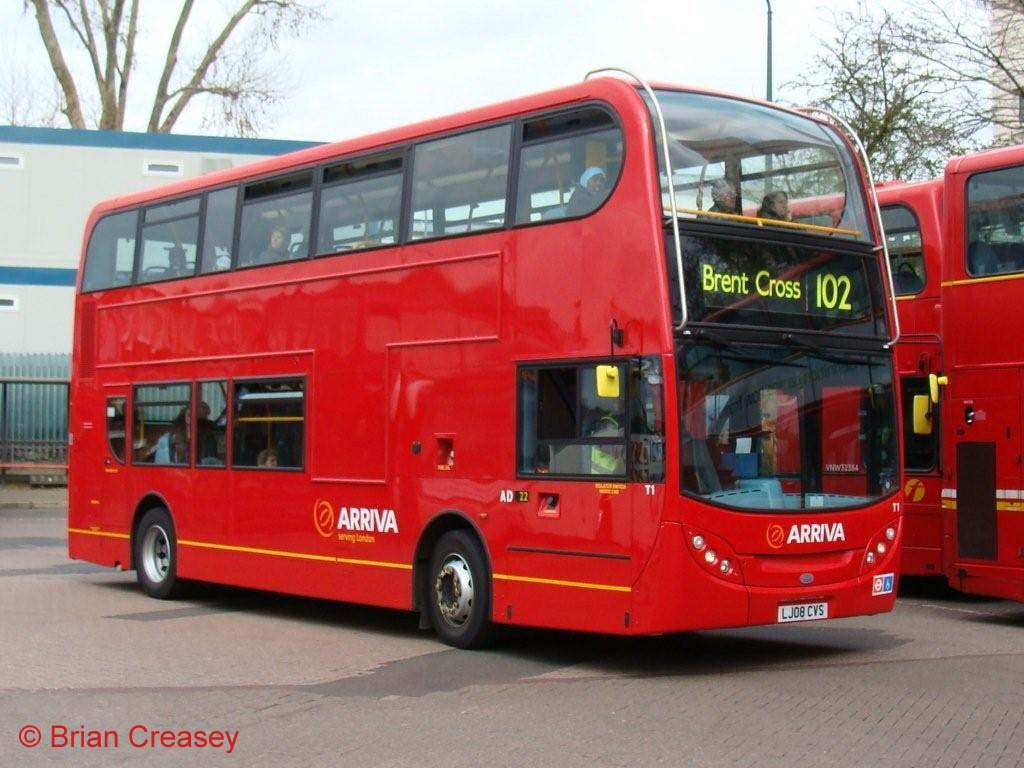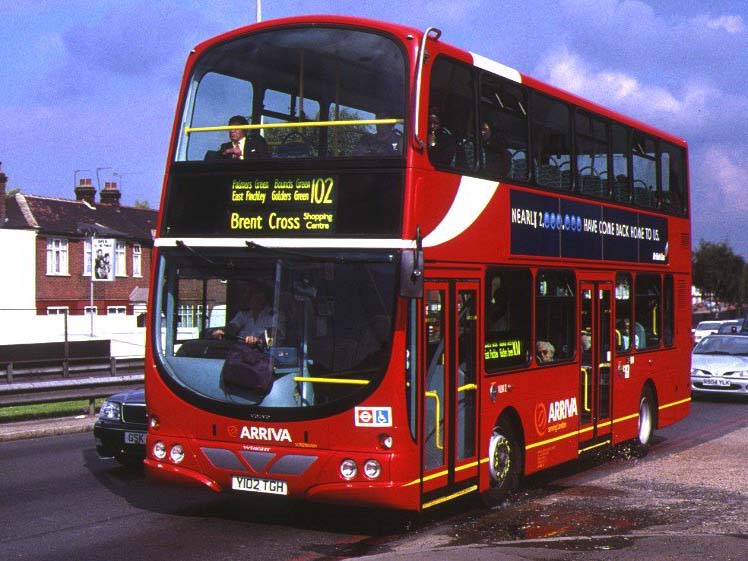 | Photo © Brian Creasey. |
Home | Bus routes | Operational details | Service changes | Operators & Garages | Photo gallery
Re-tendering in 2007 saw route 102 specified for new vehicles. This presented Arriva, one of London's largest bus operators, with a problem. Their preferred model, the DB250LF, was no longer available, while TfL have for some time had an embargo on the Volvo chassis, the other model they already had in stock, due to their very noisy radiator fans – which wouldn't be such a problem except that a design fault means they come on a lot more often than they should, and Volvo have said they are not going to let TfL hold a gun to their head! This left a choice between Dennis Trident or Scania chassis, both of which would be new to the fleet, and in the event Arriva have plumped for the former, coupled with the same manufacturer's Enviro400 style of bodywork.
The very first Dennis Trident for Arriva's London operations is T1 (LJ08 CVS), seen doing the loop of Golders Green Bus Station on 9 April 2008. Westbound buses do a loop of the bus station in order to serve common stops with other routes that start there. Arriva has for some time been the only major London operator without Tridents, and their choice of class code marks a significant departure from the earlier policy of including an L in every code, which only ceased when all buses were low floor. The class code has been used twice before – the first generation of Ts were AEC Regals, and more recently the Leyland Titan took the code.
 | Photo © Brian Creasey. |
Last time I updated this page, in 2001, the 102 was again the subject of the introduction of a major new vehicle type for Arriva. At the time, there was increasing discontent with the bus bodywork available from mainstream manufacturers Alexander and Plaxton, when a new double deck model appeared on the market. Wrights of Ballymena (Northern Ireland) had been racing ahead of themselves to develop ground-breaking new bus designs, and their new Eclipse Gemini was no exception. This was Wrights’ first double deck design – they were said not to have been keen to develop a model for what was seen as a niche market, but were persuaded to change their mind – and there are now close to 1000 in London, plus others elsewhere.
Arriva, no doubt impressed by the Wight-bodied single deck buses already in the national fleet, got the new model off to a cracking start with an order for 50 straight off the drawing board. They were destined for the London operations, and were allocated primarily to Palmers Green garage routes, first the 102 and then on the 121 and 329. Many more have since followed, taking the fleet total to 199, with a further 134 of the Pulsar Gemini variant based on DAF chassis.
They have certainly not been a disappointment. Those who know vouch for the mechanical and technical robustness of the design and the build quality, and equally importantly a good deal of thought went into designing the passenger accommodation. Even on the troublesome area of ventilation Wrights were ahead of the game in introducing ventilation grilles at the front of the upper deck to scoop in air from the roof as the bus travels along. The exterior styling is very eye-catching – while other bus manufacturers have succeeded in capturing the more modern ‘curvy’ look, they never seemed to get it quite right somehow, but Wrights at last ditched the slightly awkward look of the other double deck designs. The windscreen takes ‘curvy’ to extremes, as it has an almost circular profile! Upstairs and downstairs are neatly integrated into one, even if the Arriva livery of the time did rather rudely stick a white line across.
In the case of the 102, the VWLs corrected a shortfall relative to the contract, which specified new low floor double deckers when awarded in 1998. Unfortunately a mysterious ‘restriction’ meant that Arriva’s preferred model, the DAF DB250, could not be used. This was said to be something to do with the unusually long front overhang on the DAF, and the problem spot has turned out to be the left turn into Pennine Drive off the busy Hendon Way – which, ironically, was modified soon afterwards.
Some of the earlier VLW class are likely to continue to be seen on the route, so I have retained the previous photo, taken at the other end of the 102, VLW 2 was caught on the North Circular Road near its home garage at Palmers Green. This is one of only two that gained registrations in the old system (Y102 TGH in this case), others having been delivered after 1 September 2001.
 | Photo © Eamonn Kentell. Photo included by permission of the photographer. |
This is one of two ‘fast’ sections on the 102, which, after leaving Edmonton Green and serving Silver Street, runs along the North Circular for a couple of miles to Palmers Green. Buses then run off to Muswell Hill and East Finchley, where the route picks up the A1 to rejoin the North Circular Road briefly at Henlys Corner in Finchley. Buses dive off south for a second time to run via Golders Green, before operating on to Brent Cross (immediately north of the North Circular!) via the Pennine Drive area.
The main body of the route has not changed for many years, although it has shifted westwards a bit. In 1934 the route ran from Muswell Hill to Chingford. It was extended to Archway to replace the 27/27A via Fortis Green in 1937, and in 1940 was diverted at East Finchley via route 58 to Golders Green. Much more recently, in November 1988 to be precise, the route was diverted at Edmonton to Edmonton Green, the section to Chingford covered by a route 102A that lasted for just two weeks before being replaced by a diversion of the 144 (now 444). Finally, the 102 was extended to Brent Cross in 1991 in place of route 26, which was being withdrawn, its replacement, the 326, running to Brent Cross via Hendon instead of Golders Green. A night service was introduced in 2007, albeit only between Edmonton and Golders Green, in order to appease local residents in the Pennine Drive area.
Navigation
| Previous | Next | |
| Chronologically | 661 | 36 |
| Numerically | 101 | 103 |
Photo Gallery | Bus route list | Operational details | Service changes | Operators & Garages